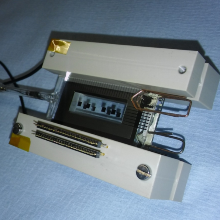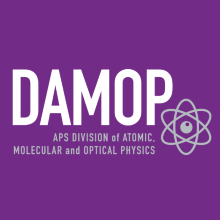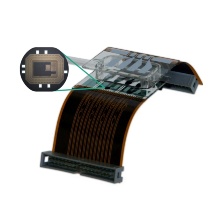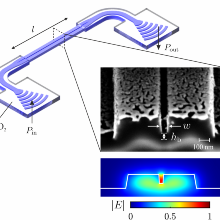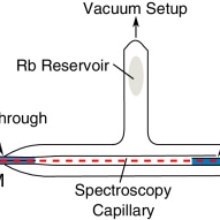Learn about...
The Project
Nitric oxide (NO) sensors are of great interest because of the role NO plays in regulating chemical and biological processes, e.g. relaxation of smooth muscle tissue, neurotransmission, and immune response. A healthy human exhales between 4 and 200 ppb NO. A person suffering from an inflammatory desease, like cancer or asthma can easily exhale a ten times higher concentration. NO can therefore serve as a marker for the monitoring of a desease.
Atoms excited to Rydberg states can be ionized very easily. In hot vapors the amount of ions is large enough to create a current in the nanoampere regime. This current signal shows by far better signal to noise properties than a pure optical detection. We want to use this measurement method to realize a new kind of gas sensor based on Rydberg excitations.
We are optically exciting Rydberg states of NO with lasers tuned specifically on transitions in NO. Since the electron of the Rydberg excited NO molecules is only weakly bound, already low energy collisions at room temperature with other atoms are sufficient to ionize a Rydberg-excited NO molecule. The emerging charges can then be measured as a current. Because the lasers are ideally narrowband is the occurrence of a current a clear indication of the presence of the molecule in question.
In a very first experiment we demonstrated the detection of 10 ppm NO in a buffer gas. This sensor can be used at room-temperature and even at normal atmospheric pressures. With the achieved detection efficiency an detection limit of 5 ppb at a realisitic medical examination seems to be in reach.
For this very first proof-of-concept study we were using two pulsed dye-lasers, which had the disadvantage though of being very broadband in the frequency domain. Our new approach will be to employ very narrowband solid state cw lasers to excite Rydberg states in NO.
Popular article on Scilight: https://aip.scitation.org/doi/10.1063/1.5046926
J. Schmidt, M. Fiedler, R. Albrecht, D. Djekic, P. Schalberger, H. Baur, R. Löw, N. Fruehauf, T. Pfau, J. Anders, E. R. Grant and H. Kübler, "Proof of concept for an optogalvanic gas sensor for NO based on Rydberg excitations", Appl. Phys. Lett., 113, 011113 (2018) or on arXiv: https://arxiv.org/abs/1801.09453

Project Publications
2024
- F. Munkes, A. Trachtmann, P. Kaspar, F. Anschütz, P. Hengel, Y. Schellander, P. Schalberger, N. Fruehauf, J. Anders, R. Löw, T. Pfau, H. Kübler, Collisional shift and broadening of Rydberg states in nitric oxide at room temperature, Phys. Rev. A 109, 32809 (2024).
- Y. Schellander, F. Munkes, A. Trachtmann, P. Schalberger, R. Löw, H. Kübler, T. Pfau, N. Fruehauf, Highly efficient real-time spatially resolved sensing of ultraviolet light, Proceedings SPIE 13109, Metamaterials, Metadevices, and Metasystems 2024 , 1310906 (2024).
- F. Munkes, M. H. Rayment, A. Trachtmann, F. Anschütz, E. Eder, P. Hengel, Y. Schellander, P. Schalberger, N. Fruehauf, J. Anders, R. Löw, T. Pfau, S. D. Hogan, H. Kübler, High-Resolution Continuous-Wave Laser Spectroscopy of Long-Lived Rydberg States in NO, The Journal of Physical Chemistry Letters 15, 10171–10180 (2024).
2023
- Y. Schellander, M. Winter, M. Schamber, F. Munkes, P. Schalberger, H. Kuebler, T. Pfau, N. Fruehauf, Ultraviolet photodetectors and readout based on a-IGZO semiconductor technology, Journal of the Society for Information Display (2023), doi:10.1002/jsid.1202.
2022
- P. Kaspar, F. Munkes, P. Neufeld, L. Ebel, Y. Schellander, R. Löw, T. Pfau, H. Kübler, Doppler-free high-resolution continuous-wave optical UV spectroscopy on the A<sup>2</sup>Σ<sup>+</sup> ← X<sup>2</sup>Π<sub>3/2</sub> transition in nitric oxide, Phys. Rev. A 106, 62816 (2022).
2020
- J. Schmidt, Y. Münzenmaier, P. Kaspar, P. Schalberger, H. Baur, R. Löw, N. Fruehauf, T. Pfau, H. Kübler, An optogalvanic gas sensor based on Rydberg excitations, Journal of Physics B: Atomic, Molecular and Optical Physics 53, 94001 (2020).
2018
- J. Schmidt, M. Fiedler, R. Albrecht, D. Djekic, P. Schalberger, H. Baur, N. Frühauf, R. Löw, T. Pfau, J. Anders, E. R. Grant, H. Kübler, Proof of concept for an optogalvanic gas sensor for NO based on Rydberg excitations, Appl. Phys. Lett. 113, 11113 (2018).
2017
- D. Weller, A. Yilmaz, H. Kübler, R. Löw, High vacuum compatible fiber feedthrough for hot alkali vapor cells, Appl. Opt. 56, 1546–1549 (2017).
- J. Schmidt, P. Schalberger, H. Baur, R. Löw, T. Pfau, H. Kübler, N. Frühauf, A transimpedance amplifier based on a LTPS process operated in alkali vapor24th (2017) (available at http://ieeexplore.ieee.org/document/8006156).
- G. Epple, N. Y. Joly, T. G. Euser, P. St. J. Russell, R. Löw, Effect of stray fields on Rydberg states in hollowcore PCF probed by higher-order modes, Optics Letters 42, 3271–3274 (2017).
- J. Gutekunst, D. Weller, H. Kübler, J. Negel, M. A. Ahmed, T. Graf, R. L. A. O. Vol. 56, I. 21, pp. 5.-5. (2017), Fiber-integrated spectroscopy device for hot alkali vapor, Appl. Opt. 56, 5898–5902 (2017).
- S. Kumar, H. Fan, H. Kübler, J. Sheng, J. P. Shaffer, Atom-Based Sensing of Weak Radio Frequency Electric Fields Using Homodyne Readout, Scientific Reports 7, 42981 (2017).
- S. Kumar, H. Fan, H. Kübler, A. J. Jahangiri, J. P. Shaffer, Rydberg-atom based radio-frequency electrometry using frequency modulation spectroscopy in room temperature vapor cells, Opt. Express 25, 8625–8637 (2017).
2016
- D. Weller, A. Urvoy, A. Rico, R. Löw, H. Kübler, Charge-induced optical bistability in thermal Rydberg vapor, Phys. Rev. A 94, 63820 (2016).
- C. Veit, G. Epple, H. Kübler, T. G. Euser, P. St. J. Russell, R. Löw, RF-dressed Rydberg atoms in hollow-core fibres, Journal of Physics B: Atomic 49, 134005 (2016).
- H. Q. Fan, S. Kumar, H. Kübler, J. P. Shaffer, Dispersive radio frequency electrometry using Rydberg atoms in a prism-shaped atomic vapor cell, Journal of Physics B: Atomic 49, 104004 (2016).
2015
- R. Ritter, N. Gruhler, W. Pernice, H. Kübler, T. Pfau, R. Löw, Atomic vapor spectroscopy in integrated photonic structures, Appl. Phys. Lett. 107, 41101 (2015).
- H. Fan, S. Kumar, J. Sedlacek, H. Kübler, S. Karimkashi, J. P. Shaffer, Atom based RF electric field sensing, Journal of Physics B: Atomic 48, 202001 (2015).
2014
- R. Daschner, H. Kübler, R. Löw, H. Baur, N. Frühauf, T. Pfau, Triple stack glass-to-glass anodic bonding for optogalvanic spectroscopy cells with electrical feedthroughs, Appl. Phys. Lett. 105, 41107 (2014).
- G. Epple, K. S. Kleinbach, T. G. Euser, N. Y. Joly, T. Pfau, P. St. J. Russell, R. Löw, Rydberg atoms in hollow-core photonic crystal fibres, Nature Communications 5, 4132 (2014).
- H. Q. Fan, S. Kumar, R. Daschner, H. Kübler, J. P. Shaffer, Subwavelength microwave electric-field imaging using Rydberg atoms inside atomic vapor cells, Opt. Lett. 39, 3030–3033 (2014).
2013
- J. A. Sedlacek, A. Schwettmann, H. Kübler, J. P. Shaffer, Atom-Based Vector Microwave Electrometry Using Rubidium Rydberg Atoms in a Vapor Cell, Phys. Rev. Lett. 111, 63001 (2013).
- A. Urvoy, C. Carr, R. Ritter, C. S. Adams, K. J. Weatherill, R. Löw, Optical coherences and wavelength mismatch in ladder systems, J. Phys. B: At. Mol. Opt. Phys. 46, 245001 (2013).
- D. Barredo, H. Kübler, R. Daschner, R. Löw, T. Pfau, Electrical read out for coherent phenomena involving Rydberg atoms in thermal vapor cells, Phys. Rev. Lett. 110, 123002 (2013).
2012
- R. Daschner, R. Ritter, H. Kübler, N. Frühauf, E. Kurz, R. Löw, T. Pfau, Fabrication and characterization of an electrically contacted vapor cell, Opt. Lett. 37, 2271 (2012).
- J. Sedlacek, A. Schwettmann, H. Kübler, R. Löw, T. Pfau, J. P. Shaffer, Quantum Assisted Electrometry using Bright Atomic Resonances, Nature Physics 8, 819–824 (2012).
2011
- D. Barredo, H. Kübler, J. P. Shaffer, T. Baluktsian, H. Giessen, R. Löw, T. Pfau, Observation of Electromegnatically Induced Transparency involving Rydberg States in Microcells, proceedings of the XX International Conference “Laser Spectroscopy” (ICOLS 2011) (2011).
2010
- T. Baluktsian, C. Urban, T. Bublat, H. Giessen, R. Löw, T. Pfau, Fabrication method for microscopic vapor cells for alkali atoms, Opt. Lett. 35, 1950 (2010).
- H. Kübler, J. P. Shaffer, T. Baluktsian, R. Löw, T. Pfau, Coherent excitation of Rydberg atoms in micrometre-sized atomic vapour cells, Nature Photonics 4, 112 (2010).
We are looking for motivated new team members!
Project Team
Project News
Contact

Harald Kübler
Head of Physics Laboratory I / Group Leader


